#Unification Media Group
Explore tagged Tumblr posts
Text
How the Moonie Media Apparatus Bought Chris Matthews’ Soul for a Pittance (2007)
WIOTM note: The following is a post from the Scooby Davis blog about the Unification Church (source)

"[Jack] Welch sincerely believed that all liberals were phonies. He took great pleasure in "buying their leftist souls", watching in satisfaction as former Democrats like Russert and MSNBC’s Chris Matthews eagerly discarded the baggage of their former progressive beliefs in exchange for cold hard GE cash."(quote found via Mercury Rising).
Being someone who follows the media, I knew that Welch had an influence on Russert's political views. I didn't realize he got his rocks off by buying the souls of people on the left. I seriously doubt that Welch reads this blog, but if he did, he might be sad to find out that Chris Matthews's media whoredom cherry had been popped a long time before he was supposedly corrupted by Welch. By the time Welch got to Matthews, Tweety's soul had been bought and paid for by Sun Myung Moon for a pittance. Sometimes I wonder which is worse: someone who never had principles (e.g., Karl Rove) or someone who once acted like a human being and then lost his way when the price was right. When I look at the Moon controversy, there are a number of people who initially took a principled stand against the anti-American megalomaniac but who changed their tune because either, 1) Moon dumped billions of dollars to help the American right; or 2) because they wanted to line their pockets. An example of the former is former Senator Robert Dole. In the 1970's, Dole was justifiably troubled about Moon's activities and his attempts to corrupt the American political system. In 1976, Dole held a public forum in Washington in which survivors and the families of victims of the Unification Church spoke about their nightmarish experiences with the cult. In February 1979, Dole held congressional hearings on the threat of cults in which discussion of Moon's pernicious activities were a prominent feature. Carlton Sherwood, a prominent paid apologist for Moon, credits Dole with setting into motion the investigations that led to the imprisonment of the cult leader for tax evasion:
For all practical purposes, this one letter [that Dole sent to the IRS calling for the investigation of the Unification Church's tax exemption] set into motion all subsequent events which, five years later, would result in the conviction and imprisonment of Moon." (Inquisition: The Persecution and Prosecution of the Reverend Sun Myung Moon, pg. 53)
That all changed in the 1980's. After attempts to evangelize America in the 1970's were an abysmal failure, Moon pretty much figured that his messianic vision didn't play in Peoria (or anywhere else in the United States) so he kept a low profile and dumped a few billion dollars into a right-wing media empire. Apparently,
Dole knew which way the wind was blowing because he let bygones be bygones and lent Moon credibility by appearing at the Messiah's "Tear Down the Cross" Washington prayer breakfast in 2003
Moon and his underlings have covered their bases with a two-pronged media strategy: 1) Subverting journalism by becoming part of the media with the Washington Times, UPI, and Insight magazine; 2) Undermining media independence with Moonie front groups that give large conference fees to mainstream journalists.
The 1992 Frontline documentary on Moon addresses this:
Narrator: Besides paying for his own media, Moon sought to influence legitimate press outlets. One vehicle was the World Media Association. [Moon's right hand man Bo Hi Pak]: " And the founder is Reverend Moon, who is deeply concerned for the world media, particularly in the battle against communism all over the world; who sees that the role of the media is so vital and so important for the salvation of our civilization." Narrator: The World Media Association sponsors all-expense-paid conferences and junkets for journalists all over the world. As Bo Hi Pak told public station KQED in 1984, the Unification Movement used the association as a weapon for a larger crusade. Pak: "But is a total war. Basically war of ideas. War of mind, the battlefield is the human mind. This is where the battle is fought. So in this war the entire thing will be mobilized, political means, social means, economical means and propagandistic means, and basically trying to take over the other person's mind. That is what the third world war is all about--the war of ideology."
The upshot is that the Moonies received journalistic legitimacy by becoming part of the media and by transferring vast amounts of money to the media elite through Moonie front groups. One of those corrupted by this easy Moonie money was Chris Matthews. To Matthews’ credit, when the Moon-owned Washington Times was established in 1982, Matthews--who was then the assistant to then-Speaker Tip O'Neil--refused to grant the Times any legitimacy by not credentialing their operatives (reporters). Matthews quipped at the time, "We work hard enough responding to legitimate press inquires." It was a principled move.
To Matthews' discredit, when he had the chance to pocket Moonie money by according the Moonie media apparatus undeserved legitimacy, Matthews took the money. Fast forward to 1989 (after Matthews left government service and was Washington Bureau Chief of the San Francisco Examiner). The Unification Church paid Matthews $2500 to speak at a conference for the Moonie front group, the World Media Association. Mathews' descent into media whoredom is recounted by James Whelan, the former editor of the Washington Times (who resigned as editor of the Times in 1984 after Moon reneged on his promise not to impose his sectarian agenda on the Times) at a conference that addressed cults and the media (click here and watch 57:35 to 1:00:25 for Whelan’s take on Matthews). To show how Matthews did a complete 180 regarding the Moonie media, the Washington Times--the rag that Matthews had previously dismissed as pseudo-journalism--began running Matthew’s syndicated column in the 1990's. Matthews was a consummate media whore by the time he met up with Jack Welch.
Addendum: James Whelan on journalists who are paid to go on Moonie junkets (click here and go to 1:09:37)
They (the Moonies) are subverting our political system. They're doing it through front organizations--most of them disguised--and through their funding of independent organizations--through the placement of volunteers in the inner sanctums of hard-pressed organizations. In every instance--in every instance--those who attend their conferences, those who accept their money or their volunteers, delude themselves that there is no loss of virtue because the Moonies have not proselytized. That misses the central, crucial point: the Moonies are a political movement in religious clothing. Moon seeks power, not the salvation of souls. To achieve that, he needs religious fanatics as his palace guard and shock troops. But more importantly, he needs secular conscripts--seduced by money, free trips, free services, seemingly endless bounty and booty--in order to give him respectability and, with it, that image of influence which translates as power.
Related articles and notes
From WIOTM note on Inside Moon’s Washington:
The relationship between Jesse Jackson and the Moonies began in 1976, when Jesse Jackson wrote a column in the Moonies NY-based newspaper ‘The News World,’ the year it launched. That said, through the 80s, the Moonies/CARP actively protested events that Jesse Jackson was involved with, including pro-Sandinista rallies. By 1989, as this article expounds on, Jackson was paying the Moonies for marketing for his campaign at Global Image Associates.
Quote from Robert Parry in ‘Secrecy & Privilege: Rise of the Bush Dynasty from Watergate to Iraq’:
"In 1976, Moon's search for growing influence in the United States seemed to be following the KCIA script. Moon started a small-circulation newspaper in New York City that featured a column by civil rights leader Jesse Jackson. Moon promoted the anti-communist cause through front groups which held lavish conferences and paid speaking fees to academics, journalists and political leaders.
On Arnaud de Borchgrave, Editor-in-Chief of the Washington Times and Friend of Gladio Terrorists Washington Post: Church Spends Millions On Its Image (1984) Moonstruck: The Reverend and His Newspaper
#media#chris matthews#news#liberalism#democratic party#u.s. politics#democrat#politics#front groups#front organizations#national prayer breakfast#carlton sherwood#world media association#Bo Hi Pak#moonies#unification church#unification church in the united states of america#unification church in the united states#american church#unification church in usa
1 note
·
View note
Note
I’m usually the kind of person that doesn’t make theories for shows and just enjoys the ones that others make for the media I consume. But I’ve never even thought about if their bodies are actually flesh and blood or not! Really cool and I like how it leans into the whole ‘Nations are eldritch beings’ aspect!
Yes I really like the idea of them being just a fundamentally different material! They're dirt and stone and muddy river water held together by ideas and beliefs. They can be made of any material - technically also human flesh - but it really does not matter. It's definitely akin to a religious ritual in some cases.
Some nations come fully formed out of rivers, others get stitched together with animal bones and prayers, some are concrete and steel beams that learned how to move. I like to imagine there are as many ways to build a personification as there are peoples.
I think the important difference between a personification of a group that formed organically versus a top-down nationalistic approach is that modern nationalist nation-building by its very nature requires conformity and subordination. A national consensus is enforced, oftentimes violently, at the expense of small, organic clusters of community. Hence, I portray the process of unification as this sort of Frankenstein-esque horror show - it is a political open-heart surgery, and if we are not careful, it kills the most vulnerable part of the population.
#writing this on the us election day of all days feels very MhhHhhhhhh#also can you tell I am an anti-nationalist leftist gay artist from my writing? probably#also while we are at it Free Palestine
26 notes
·
View notes
Note
have quite literally been waiting to see your comment on the new Irish unification meme that's going around. save me communist Irish historian. Communist Irish historian save me etc.
Well if you want my actual opinion on that article rather than just incandescent irritation I would say to the general tumblr community that one must remember 2 things: one, that people have been saying that Ireland is about the reunify for real this time since NI was created. 25 years ago they were saying this, 50 years ago they were saying it, 75 years ago they were saying it. Particularly when it comes to statements from groups like Sinn Féin, as cynical as it is, it's important to keep in mind that they and groups like them are political parties who want support and ultimately people's vote. In order to get these things, they tell people that their main reason for existing will be accomplished, no matter how far fetched some of their claims are, and, as noted above, this has been going on for a long time. I was reading just earlier today about articles published in the 30s with the same general message as this new thing going around and I think it's pretty clear what happened as a result of those lmao.
The second is that not only does not everyone in NI or even in the ROI want reunification, the bloc of people who really really really really don't want it is powerful enough in the north that any steps towards Irish reunification would not happen without death. People would die. It doesn't matter how much social media users who don't know a damn thing about the situation want it, the current political reality means that reunification would be paid for in a great deal of blood, because Irish people who are not hard-line republicans, and I cannot emphasise this enough, exist. Hence why it's kinda ridiculous to assume that anything will happen just because some guy said that Irish reunification is once again closer than ever. lol lmao l + ratio + talk to Northern Irish people + read Irish history + be realistic
41 notes
·
View notes
Note
what do mainland greeks and cypriots think of eachothers ?
The Helladites (the Greeks of Greece) have a pretty unanimous opinion about the Cypriots. They all think Cypriots are Greeks far far away who are prevented by Turkey from the Énosis (unification) of Cyprus with Greece. Helladites think of this in emotional terms, rather than strategic or political ones (ie wanting Cyprus just because that would expand the country and make it stronger). First and foremost, they think of it as Greeks who are kept apart from the rest of Greeks and I perceive this as a honest sentiment amongst the people. Other than that, Helladites also believe Cypriots run their country better and that their economy is stronger (per capita). Helladites find the Cypriot accent and dialect “heavy”. Helladites love Halloumi, the Cypriot national cheese, maybe not as much as feta but they still hold it to a high regard.
I feel like the Cypriots have more mixed and stronger opinions but I don’t know if I am an expert because I have interacted with few Cypriots in my life. Historically Cypriots wanted the unification with Greece. After the Turkish invasion of Cyprus and Greece’s failure to protect Cyprus let alone that some of its actions made the situation worse, Cypriots were very disappointed and angry at the Helladites. Cypriots call Helladites “kalamarádes” with a touch of irony, which means “the educated ones”. I don’t know why actually, probably due to speaking the standard textbook Greek? I honestly don’t know. Cypriots make fun of the Helladites for their poorer English accents and they defend their dialect for preserving some archaic elements Standard Modern Greek does not.
(Greek) Cypriots are probably grouped in three categories. The largest group is those whose disappointment has started cooling down and they want tight bonds with Greece in all aspects, however they want to keep their sovereignty separate, maybe due to trauma and distrust, or maybe because if we ever attempted something like that, Turkey would start WW3. This is already more or less our situation but there’s always room for further bonding.
The second group are the Cypriots who still want the Enosis. I was reading a comment in YouTube by a foreign tourist saying how he saw more Greek flags in Cyprus than in Greece. Then I had seen in the news about a Cypriot raising one of the biggest Greek flags in the world in a building, I don’t remember exactly why. Greece had some victory in sports or some event or something and he was celebrating like that. Also, this is not just this group of people but an official fact: Greece and Cyprus share the same national anthem. They have the same history books in school. The Cypriot president comes to Athens to attend the Greek Independence Day military march there. Most Cypriot artists come to study and become famous in Greece. There are a lot of Cypriot singers that are crème de la creme of Greece. In the last years there is also almost every year a Helladic - Cypriot TV production. In general the famous people of the two countries are shared totally.
There is a third group of people which I believe to be smaller but it’s particularly promoted by the British zone of influence in the island. Those claim to be “just” Cypriots, with Cypriot being perceived as both a nationality and a separate ethnicity, and wish to cut the so many ties with Greece. I don’t think they are many because their beliefs are not reflected in however the majority of Cyprus and even the state of Cyprus officially act in relation to Greece.
Helladites and Cypriots often pick up silly fights on the social media, where each accuses the other for lack of support or understanding. That one time we gave 4 instead of 12 points to Cyprus in Eurovision almost started a diplomatic episode 🤣 Then Cypriots always participate in reality and contest TV games in Greece and when the winner is voted by the public all of Cyprus votes for the Cypriot only whereas the Helladite participants’ votes are dispersed throughout Greece and as a result nearly always a Cypriot wins in Greece’s game tv shows which at this point makes Helladites mad and accuse Cypriots of bombing the televoting. (Cyprus is always able to vote in Greece tv shows.) You know, such serious stuff.
All in all, from the few Cypriots I’ve met, if you don’t hear the accent, you can’t tell them really apart from a Helladite, despite the actually long marine distance between Greece and Cyprus. By a Helladite acquaintance who lived in Cyprus for a while, I was told there were some small differences in the lifestyle and society but they didn’t expand more. Cyprus is a smaller country and therefore Cypriots tend to stick together more, however most of the (few) Cypriots I have met had flawless smooth friendships, affairs and interactions with Helladites, more like they were too Helladites from a remote Greek island than from a different country.
That’s my personal recollection but again I haven’t met many Cypriots so maybe something here is inaccurate idk
15 notes
·
View notes
Note
No, no, you can keep rambling about cowboys if you want, it's interesting.
Okay! So!
The traditional vaquero lifestyle has roots in Paldea hundreds of years ago with the rise of the hacienda system, dating back somewhere between the fall of the Paldean Empire around 1000 years ago and the conquest and unification of modern Paldea roughly 800 years ago. The sudden acquisition of land during Reconquista allowed kings to reward their nobles and knights for their military service by granting them extensive holdings of land. Paldean haciendas produced wine, grain, oils, and— the most relevant to our current topic— livestock.
The newly-conquered southwestern lands possessed a dry climate with sparse grass, and thus large herds of cattle required vast stretches of land for sufficient foraging. The need to cover such large distances gave rise to the development of the Cyclizar-mounted vaquero— ranch hands who would herd and manage the livestock. This style of cattle ranching spread throughout much of Paldea.
During the Paldean colonization of the Americas, settlers brought their cattle-raising traditions as well as both Cyclizar and domesticated cattle Pokemon to what today is [Mexico], parts of Unova, and much of Central America. Their traditions were transformed by the geographic, environmental and cultural circumstances of the land, evolving into the modern [Mexican] vaqueros and caballeros, [Argentinian] gauchos, [Venezuelan] llaneros, so on and so forth! With many of these groups, Cyclizar gradually fell out of fashion in exchange for native Pokemon of the area (Zebstrika, Rapidash, Mudsdale, etc.) which were easier to obtain. The different mount preferences gave rise to distinctions in cowboy traditions. I'd be happy to talk more about different types of cowboys and mounts because it’s really interesting but I'm getting a bit off topic!
The vaquero heritage had an influence on development of the modern cowboy traditions in Unova, Orre, and the surrounding regions. Orrean ranching has a cabellero heritage that originates from the Hispanic and indigenous groups from the area. The South Unovan ([Texan]) vaquero tradition melded Tejano techniques with ranching styles of surrounding regions, while the "buckaroo" or West Unovan ([Californian]) tradition resembled Northern [Mexico] and vaquero traditions.
Nowadays, the South Unovan and West Unovan cowboy traditions tend to be the most prominent in modern media. But lesser-known yet equally distinct cowboy traditions such as the Alolan paniolos are still holding strong!
#jai posts#pkmn irl#rotomblr#the mailbox#jaime's ramblings#redux worldbuilding#<- i guess???? not really but might as well#// sorry guys as a texan i am legally required to infodump about cowboys if prompted /silly#// any locations that are in [brackets] are just me not having any names for fan-regions based on these locations
7 notes
·
View notes
Text
Recently surfaced North Korean footage has captured the North Korean government's crackdown on citizens, including teenagers, for consuming banned South Korean media.
The footage, obtained by South Korean production company KBS Media, shows a public denunciation session where a group of young girls, including a 16-year-old student, are publicly humiliated and arrested for the offense.
Pyongyang maintains tight control over the flow of information within its borders, forbidding citizens from accessing foreign music, films, and TV series. Those caught violating these restrictions face severe penalties, including public shaming, imprisonment, and in some cases, execution.
The Kim Jong Un regime views South Korean media as a direct threat to its ideological purity and legitimacy, heightening crackdowns on such content in recent years.
The footage shows a young girl identified only as Choi, breaking down in tears during a public denunciation session—a form of organized group criticism employed by communist regimes such as North Korea, the former Soviet Union, and China under former Chairman Mao Zedong.
"I made the mistake of listening to and distributing impure published propaganda," Choi said into the microphone during the hearing, according to KBS's translation. The footage then shows her being led away in handcuffs.

Though such public punishments are commonplace, a North Korean defector surnamed Jang who fled the country in 2020 expressed shock at the public punishment of someone so young.
"I've never seen school students punished like this before," she told KBS. "The fact that they were handcuffed is really shocking to me."
The video is part of over 10 recordings obtained by KBS, most of which were produced after May 2021.
North Korea closed its borders in early 2020 at the onset of the COVID-19 pandemic. The country finally reopened its borders to returning citizens in August 2023.
Video under the cut
youtube
North Korea's rigid control over media intensified in 2020 when Pyongyang enacted what has been dubbed the "evil laws" as part of its crackdown on perceived external threats to ensure loyalty to the regime.
These laws target foreign cultural products, including media and also South Korean slang.
"The North Korean authorities have been policing and cracking down on foreign culture for over a decade now, but the three new laws formalize and strengthen the draconian punishment for the offenders," Ethan Hee-Seok Shin, a legal analyst for Seoul-based NGO the Transitional Justice Working Group, told Newsweek.
Shin pointed out that the degree of punishment is linked to the gravity of the offense.
"The distributors are generally more harshly punished than the consumers," he said. "Similar to how other countries would deal with narcotics-related crimes."
The South Korean Ministry of Unification's 2023 report on human rights abuses in the North highlighted testimonies from defectors who witnessed public executions of young adults simply for watching K-dramas and listening to K-pop.
Pyongyang earlier this year amended its constitution to label Seoul as its primary enemy.
Despite the harsh punishments, South Korean media continues to penetrate North Korea, often via activists in the South who send USB drives filled with dramas and music into the North using balloons.
USB drives filled with South Korean media sent north by activists in the South have further inflamed tensions. The North has retaliated by sending balloons south laden with trash, and in some cases human waste.
A U.S. State Department spokesperson previously told Newsweek that Washington, DC advocates human rights and the free flow of information in and out of North Korea and condemns the country's three "evil laws" and "draconian punishments and youth targeting."
The North Korean embassy in Beijing, China, and U.S. State Department did not immediately respond to written requests for comment.
10 notes
·
View notes
Text
So. Every June, I try to challenge myself by posting something for Pride Month. For the past couple years, it's been ships with cute little pride flags. This year, the priority focus will be on the Trolls Summer Gift exchange. But at the very least I'd like to show ya'll the ones I've made in the past.
2022 bundle:

Bi Hiccup x Gay Jack. Fun fact: This was the first gay couple I've ever laid my eyes on as a young child. I saw this ship and thought "I want that kind of relationship."

Bi Tony x Gay Rudolph Watching the 2017 movie, these two reminded me of Luca and Alberto so much.

Aro Merida You get it? Cuz she's an archer. It's funny. Laugh.

Bi Nan Fang x Ace Fu Yao The headcannon was based off of a fanfic I read a while ago.

Demi Ace Xie Lian x Gay Hua Cheng. I sevearly enjoyed the series. I occasionally eat fics of these two as comfort foods.

Pan Xu Xuan x Trans Xiao Bai White snake was basically 2 hours of "What you are doesn't matter, it's who you are that matters", THEE Pansexual anthem, and then the second movie Turned Blanca into a guy? This is cannon.

Ace Liu Qingge x Bi Shen Yuan Imma be honest. I didn't like SVSSS very much. Yandere's are not my cup of tea. And I was really hoping Shizun would have gotten with Liu-shidi instead.
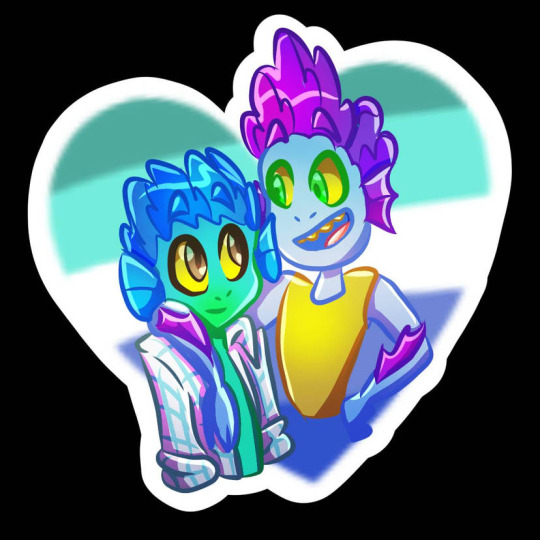
Gay Luca x Gay Alberto I'm so glad Luberto was actually confirmed to be somewhat cannon. Though Nowadays I see Luca as bi, cuz if we're counting the concept art as apart of the lore, then Luca had a crush on both Alberto and Giulia.

Gay Jade x Gay Katie. Kate is the first character I actually felt scene as a queer person.

Genderfluid Shi Qingxuan I freaking love them so much. Easily my favorite character.
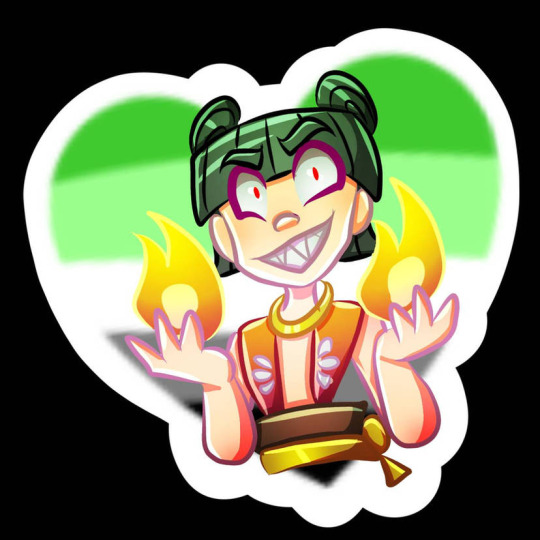
Aro Nezha This kid knows chaos and only chaos.

Pan Adam x Gray Ace Freddy I saw this crossover on DA and thought they made so much sense together. Adam the literal personification of nature, and Freddy the unification of humanity and animals.

Non-Binary Merz x Lesbian Alice These two are OCs of mine.

Aro Lesbian Isabela and Aro Lesbian Elsa. I ship this in a sort of queer platonic way. Like a "we don't really want to date people, but everyone thinks we're dating, and we just don't care enough to correct them." kind of way.

Genderfluid Camilo I want the ability to shapeshift so badly.

Pan Ao Bing x Bi Xiao Jiu Ya'll get brownie points if you know which Ao Bing this is and double points if you know who Xiao Jiu is. Lol. It was a random crossover ship I made because the company liked to crossover their medias for advertisements, and we see the adults interacting and having fun, and Nezha joins them. But we don't see the two teenagers interact at all.

Bi Verta x Bi Li Yunxiang Another crossover ship I made up cuz I didn't see a lot of Nezha Reborn and White Snake crossovers. Which surprised me, especially after Green Snake.

Gay Jiang Ziya x Gay Shen Gongbao These two lived in the same house together for 10 years and adopted a daughter together. I am convinced these two are a married couple.

Bi Mirabel There was a little bisexual rainbow on her dress. That's proof enough for me. Lol.
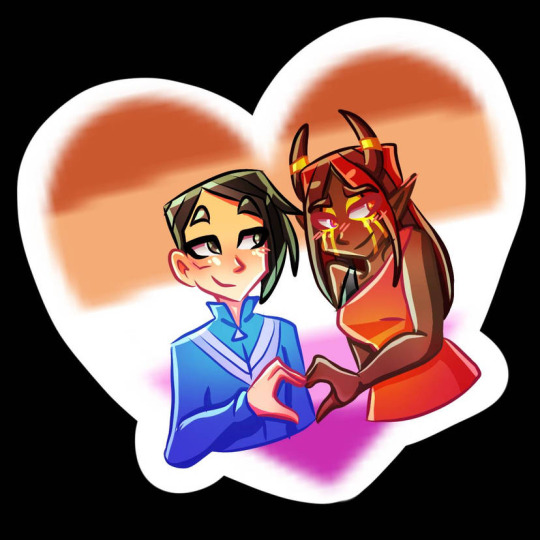
Lesbian Amaya x Lesbian Janai I loved seeing their dynamic in the show.

Non-Binary Kazi I love them. I'm glad they got more attention in the show.

Lesbian Susie x Trans Noelle "Why does Noelle have antlers. Is she trans? The Null the Null the Null the Null..."

Non-Binary Kris I love them. They literally never said a word, and I love them.

AroAce Krel Based on a comic I made.

Aro Blaze Another OC.

Aro Douxie Idk why, but I get that vibe from him.
2023 Pack:

Furry Omni Toby x Furry Demigirl Darci The moment Darci said she didn't want people to like her just because she was a girl, I felt that in my soul.
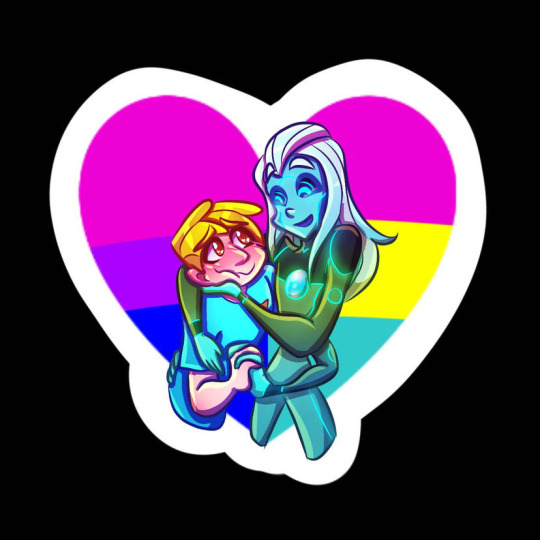
Bi Steve x Pan Aja I am not convinced Steve is straight.

Pan Simon x Gay Ao Bing This ship was inspired by a youtube video that had a list of crossover ships, this being on of them. And I freaking love it.
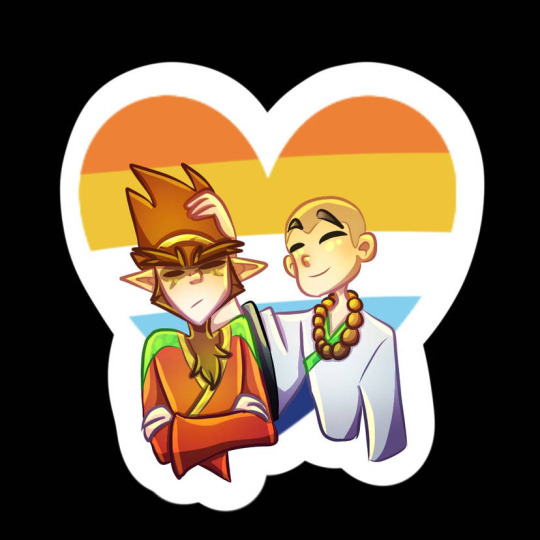
AroAce Sun Wukong and AroAce Tang Sanzang In Monkey King Reborn, out of everyone in the friend group, you can just tell that these two cared about each other the most. And I think that's just sweet.
Fuck. I can only have 30 images per post. I'll reblog with the rest of the 2023 pack.
12 notes
·
View notes
Note
"No one put all the pressure on Ruby!" Ruby did. She's the one who's put the burden upon herself. You're a fucking idiot. Every single one of your posts is complete fucking idiocy. You are the most incompetent and brainless and media-illiterate 'critic' I've ever seen. You cannot put two and two together of an incredibly simple story. Get a life, you loser. One that doesn't revolve around kissing the asses of lowlifes who can't stand women in cartoons.
Ruby: I can't do this anymore
The Story: Okay. Then don't
Ruby: I have to. The world depends on me
The Story: It literally doesn't? Your career is really popular with numerous, powerful fighters all working to protect Remnant. Even your Silver Eyes have been seen in three other characters, one of which was supposedly The Best Huntress Ever
Ruby: I'm trapped fighting this impossible war, never ending...
The Story: Didn't you leave home, like, four months ago? You haven't even tried to come up with a solution to Salem's immortality and, last I checked, you're not the one reincarnating into innocents due to a God's curse
Ruby: All the responsibility is on my shoulders
The Story: There was an established, secret group of incredibly powerful huntsmen fighting this war before you were even born
Ruby: So much pressure... I don't know what to do...
The Story: Look, kid, this is gonna sound harsh, but you need the truth, not more reassurance that's going to feed your fantasies: that pressure is 100% coming from you. Is that an awful problem you're struggling with? Yeah, let's snag you a therapist, but in the meantime the narrative solution is not to have you rediscover how to keep going despite this war being "forced" on your shoulders. We don't need more scenes where people pat you on the head and tell you that you're doing your best, reasserting this idea that you really are Remnant's One True Savior, Forced By The World to Suffer Endlessly and it's totally fine that your ignorant choices had devastating, world-wide consequences because you simply "had" to take the initiative. Given that you're not a Chose One, the solution here is to acknowledge that this war does not revolve around you. Your view of the situation is incredibly warped and until you acknowledge that this is a problem of your own making - that you actively chose this responsibility at every turn, tore it from others, and have created additional problems through your mistakes - you're never going to make any headway with your mental health or the war. This has been going on for centuries, Ruby. Remnant doesn't need a teenager to solve this impossible problem in six months time, it needs you to put aside your ego and decide how you're going to help. Not fix everything because you want to be the hero of an epic story! But just help.
Ruby: How can I possibly save all of Remnant?
The Story: Oh boy, weren't you just telling the world that they need to unify? Come on, let's go look up the word "unification" and discuss how that clashes with individual responsibility.
96 notes
·
View notes
Quote
Every person offers immediate social signifiers with their clothing. Sometimes this is obvious: clothing covered in logos with a certain designer’s name, outfits comprised of attention grabbing colors or loud patterns, garments and uniforms associated with particularly career paths. Even the person picking their smelly sweatpants off the floor and hastily pairing them with a wrinkled t-shirt is offering a social signifier, either I do not care what other people think of my clothing or I want people to think that I do not care what people think of my clothing. It would be ridiculous and ahistorical to claim that there was a time in modern fashion where clothing didn’t function as a form of social exchange or that social identity has ever been extricable from consumption. But our contemporary understanding of identity, by way of these “niche aesthetics”, are not social identities later commodified. They begin with consumption, any sort of cultural or philosophical unification is a latter addition. A single, branded item becomes the basis for a group identity; one does not need to own this item, simple aspire towards what it represents and place themselves in a network of like-minded consumers. The structures of social media heavily reenforce commodity-based niche aesthetics. Certainly, influencers, celebrities, and socialites have always influenced people into purchasing things or adopting specific trends and styles. What is unique to our contemporary media landscape is the role in which algorithms play in building our consumer identities: Tik Tok’s main feature is its endless, algorithmically generated For You page. Instagram has continually increased its focus on suggested content, both in the Explore page and on its main feed. Specific objects become units of data, like a geotag or hashtag, which can be analysed and promoted based on a user’s previous interaction history. Without any human involvement, a social media algorithm can notice that some users who enjoy content about female-driven coming-of-age movies will be receptive to fashion videos that feature iced coffee in glass mason jars and platform oxford leather shoes. The algorithm then promotes content that synthesizes the most trend-friendly images, ideas, and products. In this way, contemporary social media does not reenforce niche identity groupings but actively creates them, selecting the exact products and commodities that can be grouped together to target and captivate specific markets.
charlie, Personal Style Is Dead And The Algorithm Killed It
60 notes
·
View notes
Text
Unification Church in tough position two years after Abe shooting
July 7, 2024
As Monday marks the second anniversary of the fatal shooting of former Prime Minister Shinzo Abe, the Unification Church finds itself in a difficult position as the incident shed light on the religious group's controversial practices, such as collecting massive donations from its followers.
The controversy was fueled by media reports that the shooter, Tetsuya Yamagami, 43, cited his personal grudge against the Unification Church as a motive for the attack. He reportedly believed Abe had ties with the group, to which his mother is said to have donated at least ¥100 million.
Since November 2022, the culture ministry has repeatedly exercised its right to have the group respond to its inquiries. And in October last year, the ministry asked the Tokyo District Court to issue an order to dissolve the group, alleging violations of the Civil Code.
On the case, the district court heard the views of both the government and the religious group for the first time in February this year. The hearing was held behind closed doors. The group claimed that it had received donations as part of its religious activities, and argued that the government seeking its dissolution, as Yamagami wanted, is an abnormal situation.
Discussions have continued in writing, but the case looks certain to be prolonged. A Unification Church source said that the hearing process has not even reached the halfway point.
To prevent the Unification Church from moving its assets before a court decision, the ministry in March designated the group as a religious corporation subject to stricter asset monitoring. The same month, the district court found that the group had refused to respond to the ministry's inquiries without proper reasons, and ordered it to pay a penalty of ¥100,000.
Meanwhile, the Unification Church has filed a series of defamation lawsuits against lawyers, journalists and others who made remarks critical of the group, but the lawsuits have been dismissed.
On a lawsuit in which a daughter of a former follower is seeking ¥65 million in damages over the group's solicitation of donations, the district court ruled in favor of the group in 2021, and Tokyo High Court upheld the ruling in 2022.
But the ruling may be overturned by the Supreme Court. In June, the top court's First Petty Bench held a hearing on the case, a necessary procedure if it is to override the lower court ruling.
The focal point is whether the top court will find a memorandum between the former follower and the Unification Church to be valid. In the memorandum, the former follower promised not to file a lawsuit for a refund from the group.
The district and high courts ruled that the memorandum was valid. But if the Supreme Court overturns the view in its ruling scheduled for Thursday, it could have implications for similar cases.
2 notes
·
View notes
Text
As of tonight I have watched/read/played every piece of media in relation to the base story of Persona 4 and here is just a random grab bag of thoughts from that experience. Spoilers abound, mostly for the animation and manga.
-the best way to experience the story outside of just playing the game, if you want to do what for some reason, is reading the manga then watching the Golden anime. The OG anime is a lot of mediocre to bad with pockmarks of good, not worth a full sit down.
-that said if you want to watch some of the OG anime go with all the episodes up to Yukiko being saved (1-4), mitsuo’s dungeon and the summer vacation duology right after (11-14), the justice and hierophant focused episode (18), and then all of endgame (21-26).
These episodes either do a really good job expanding on what was already there, introduce new ideas and scenarios definitely not possible within the constraints of a video game, do a super solid job covering and even improving upon iconic and memorable moments in ways only the medium of an animation retelling can provide, or just have fun or funny bits. My fave is def episode 13, where Nanako becomes a little detective trying to investigate Yu’s hectic life.
-I really appreciate how each version of Yu is wildly different in these medium’s. P4A Yu is kind of a dick and lame at many points, but has the capacity to be open hearted. Manga Yu starts as cold and distant but eventually becomes an emotional and expressive individual that fights for his feelings. And P4GA Yu feels the ‘manliest’ of the bunch with very strong convictions and a level-head with no fear to speak his mind or thoughts. A lot of tiny differences to enjoy.
-there is the consistent fear of abandonment and loss of friends in Yu’s character each series captures so differently but uses nonetheless. P4A Yu also abandons the truth because of his fear and even develops a shadow that represents that. Manga Yu goes between acting rashly and angrily or withdrawing and hiding his hurt when confronted with the possible loss. P4GA Yu gets emotional and trapped in the idea of what’s the point if he risks using everyone, feeling a burden of needing to protect those bonds at all costs.
-also the fact Yu is 100% ride or die for any wild scheme, even the ones he knows won’t work is a trait I’m glad exists in every version of him. He’s just happy to be involved.
-Also Adachi, the supplementary material really made me finally appreciate Adachi as a character. After interacting with him in the game I was never too sure how to feel about him, but the anime(s)/manga finally helped me grasp his character and how I feel about him. As well as why I see the various interpretations of him that I do.
-Marie being included in more things in the Golden animation was sorely needed and a welcomed addition. When the Investigation Team was saying how Marie is also their friend I could not help but think how the team as a whole had only met Marie around 5-6 times at most through her social link. By putting her in more major scenes this actually made her feel like an unofficial member of the group and I believed they were friends.
-I very much enjoyed the way P4GA handled the unification of Izanami’s two halves. I’m probably just a sap but I very much love concepts of accepting the rage and hate-filled parts of yourself and that binging them joy and peace, quelling that fury. Izanami can be quite the tragic character from interpretation to interpretation, so to see them take a stance where it’s not a fight but a comforting hug given by Marie to Izanami that defeats her, I’m a sucker for it.
-Yu needing to free Marie from a bamboo forest and the ultimate Persona associated with Marie being Kaguya is Good Symbolism and Foreshadowing™.
-while it was definitely only done for cool factor in the manga/anime, but within the context of game mechanics Adachi being able to control and get aid from multiple Reapers in his dungeon is mortifying.
-I have come to the conclusion Yukiko and Rise are mini-gremlins in two different fonts. Yukiko will do and say the silliest to the wildest things because it brings her joy. Rise is attention seeking in a pampered cat kind of way. I cannot expand on this sadly but I hope the vibes can be expressed.
-Naoto being very perceptive but socially oblivious and one track minded is actually quite funny and charming. This is best illustrated in the Christmas episode of which I will say no more, it’s a fun little experience.
-the ‘ame-no-sagiri’ in shadow Teddie’s head’ contributed nothing to the plot/story though. Kinda actually takes away from shadow Teddie tbh but that’s more a nitpick than anything.
-the anime shadow fights are good, but they are GREAT in the manga. They feel so much more personal and productive than ‘beat the thing so it goes back to normal so you can accept it,’ while also carrying they same wonderful flow and dynamics you can see in the animation.
I might post more thoughts if I have any later. I could do an analysis but tbh I would just be repeating what a lot of people have already gone over. I’d rather focus on my own projects because this means now my research is done and I can start writing my fanfiction! I’ll talk about that more later. Can’t wait to share it~
#persona 4 the animation#persona 4#persona 4 golden#persona 4 golden spoilers#yu narukami#tohru adachi#persona 4 marie#persona 4 manga#persona 4 golden the animation#persona 4 spoilers#Sometimes research for a fanfiction is watching nearly 200 hours of the exact same thing over and over again in slightly different ways
18 notes
·
View notes
Text
Glauco White Headcanons;
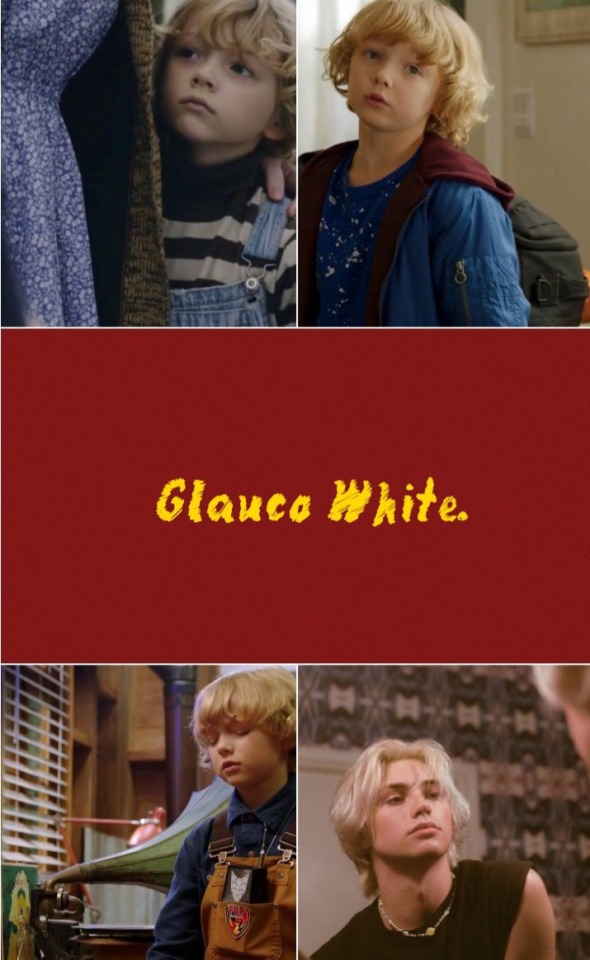
His full name is Glauco Huxley White.
He is the son of Snow White and Prince Florian.
Which makes him the prince of Charmington.
He has a few nicknames such as White the Knight, G.H, G.W, Glaucy, 'Lauco, Gla, Goofy Glauco, Glauco the Gent, Glaizer, and Glauco the Genuine.
Glauco is 19 years old by the time the events of the pocketwatch roll around.
He and Danny are teammates on various teams which has made them both bestfriends and Auradon Fighting Knights (Team name).
He has a pet horse named 'Breezy'.
He also has a pet parrot that he not so jokingly refers to as his brother named 'Polly'.
Glauco's favorite colors are red, white, dark blue, and gold.
He has blonde slightly curly hair, skin pale as snow, and green eyes.
He thinks bow ties are cool and usually wears one or a tshirt with a fake one on it.
Glauco loves dancing, playing sports, baking, cooking, and archery.
Unlike his mother, he can't sing.
His favorite royal media is InstaRoyal.
He hates ZapChat, though.
He finds the Auradon Bedtime podcast soothing and listens to it before he goes to bed every night.
His favorite isle business is Hearts Salon, Dr. Facilier's arcade, and Shan Yu's Dim Sum.
His favorite Auradon business is Evie's 4 Hearts and Tiana's Palace.
His favorite game is Go-Go Ballroom Dancing.
His least favorite game is Crown of Castle.
His favorite band is, ironically, The Dragon Slayers.
His favorite song is 'Take back the knight.'
He is apart of the school news paper and had nearly been picked out of it several times alongside Red because of their antics.
His least favorite class is smiling because he thinks (privately) that is an unnecessary and even rude class. Hadie likes to tease that it's because he knows his smile sucks.
His favorite class is jousting.
Glauco's favorite sports are Tourney, Foulball, jousting, horseback racing, and Doomball.
His least favorite sport is Swords and Shields because he is no good at swordfighting.
His favorite drink is Eggnog.
His favorite food is Pizza.
His favorite candy is Dwarf Gems.
His least favorite candy is Posion apples for obvious reasons.
When he was little, he had a blue and red flannel baby blanket and a stuffed deer that he named 'Blue'.
Which is ironic considering he has hated Christmas ever since the evil queen turned him into a Christmas tree as a toddler. Something he still has nightmares from.
Glauco's favorite teacher (other than Coach Jenkins) is his biology teacher, Abigail.
His least favorite teacher is unsurprisingly, Mr. Deley.
His favorite book is 'Tales of the Peculiar'.
His least favorite holiday is King Beast Honorary Holiday and unification day.
He collects fossils and rocks.
Something that still gives him nightmares to this day.
Glauco is allergic to Shellfish and Calms.
His favorite dance is the Beast flop because of the name alone.
Out of the group, he gets along with Hadie the least. Considering that Glauco is extremely friendly, that isn't saying much.
The blonde can be described as the following: Shy, impulsive, friendly, athletic, and protective.
He is very close to both of his parents.
He and Chloe are cousins via their dads.
Glauco grew up being babysat by Chad, Evie, Doug, and the other dwarf's kids.
He does his best to steer clear of apples and apple flavored things.
His first word was 'Mama'.
Glauco wants to be a reporter, a professional tourney player, or a detective when he grows up.
Because of his want to be a reporter, he has become very good at lying and acting.
Other clubs he is in include the cooking and sewing club, and the debate team (which Red dragged him into claiming he needed to get better at standing his ground if he wanted to be a Detective or reporter).
The reason he is so shy and anxious is because once when he was little, he joined the annual singing competition. He was so bad that no one let him live it down, so now he finds it hard to find the courage to do things like that and to open up to new people.
He is dating Shan Deja.
#descendants#disney descendants#Glauco White#melissa de la cruz#the pocketwatch#rise of red#descendants headcanons#snow white#etc#pocketwatch au
16 notes
·
View notes
Text
The power of your style
Ana Luíza Porchat
Have you ever stressed out over the outfit you would wear to a party and started screaming that you have nothing to wear? Couldn't you wear your cool top that you have been planning in your head despite the weird looks you would get in school? Have you asked for a friend's opinion on your gear? If you remember how life was as a teenager you probably went through at least one of these situations. Young people have a bigger tendency of considering they have to prove themselves, in spite of having lower confidence. The influencer and fashion blogger Monique Meads says "they believe that they need to fit in somehow. By copying the fashion trends around them, they can feel like they belong to the world. Teenagers use fashion to hold friendships and boost their self-esteem by “mirroring.”". Based on that, is why talking about the establishment of fashion trends and its reflection on youth culture since the 60s is such a fundamental topic.
Since the beginning, clothes were highly associated with social interactions and most of the trends signify a safe space for youth. Fashion recently became an echo of teens' mood, personality and self-esteem. In addition, nowadays young people are the most style-oriented and construct different aspects of their lives based on appearance. The influence of social media on the process of establishing certain fashion trends of the youth intensifies the unification in fashion. Social media has facilitated the amplitude of reach of the different trends, making it easier to purchase and copy clothes. "There is a generation that, since birth, has lived with another powerful media, the Internet. In front of the new devices, these young people don't maintain the same passive attitude that their parents and grandparents had towards the means of communication available to them" (from the book Cultura da Rebeldia: a juventude em questão). This constant access to the internet world plays an important role in establishing fashion and not only did social media make it catch on as fast as it did, technology improved the likeless of the fads to switch as much as they do now (Fashinnovation).
Starting in the 60s, young people were included in a category called "youth". When the industries began to notice they were "capable of setting trends and spreading fashion", this decade became a synonym of a change in attitude, a youthful revolution. According to Elle magazine's fashion history post, teenagers had specific clothing (more colorful and casual, contrasting with adult ones), being strongly influenced by tv shows and music. Looking back to each one of the past decades or even years, we're able to recognize specific trends that characterize the social environment and, in consequence, the young people that grew influenced by each one of them. Punk, rock, groove, indie, hippie,... All of them have distinct soundtracks, hairstyles, makeup, jewelry and, mostly, clothes. Even comparing the early 2000s fashion to the 2010s' you'll notice a gigantic difference, because the popular culture and styles that were trending can drift very quickly.
Youth culture is a very broad term, having the mission to englobe all the different categories that young people create. The recent change in fashion trends influence the youth and end up suppressing the diversity of youth culture. Even though there are different trends happening simultaneously, fashion has always been used to manifest which group you belong to. Furthermore, it becomes more than your identity, because the different singularities are quieted by peer pressure and trying to fit in. Nobody wants to stand out, making it difficult for those with a unique personality.
In conclusion, when we talk about fashion we refer to it as a reflection of the different categories of your life, like your age, group or culture. The various fashion trends are a way to manifest those aspects related to the social background the youth grew up in over the past 60 decades specifically. Many things might influence how a person chooses their style, however the role of social media is essential to consolidate mass fashion. Evolving through the years, the identities and attitudes have shifted together with fads, creating a bigger generation gap. The representation of youth culture through fashion became today a symbol of broader group characteristics, hiding individual personalities. Considering the ideas presented here, shouldn't we reflect if what we wear is simply our style or are we mirroring different concepts through our outfits?
3 notes
·
View notes
Text
Lucanamarca: When Imperialism Lies to Hinder a Global Revolution

The battle in Lucanamarca in which nearly 80 people lost their lives also has tremendous criticism against the Communist Party of Peru—also referred by the media as the "Shining Path". It has been referred to as a massacre by many, however, not usually mentioned in these reports are that less than 20 of those who died were innocent people caught in the crossfire. The majority were Rondero reactionaries who had been involved in genocidal activities.
In order to contextualize the battle of Lucanamarca and the actions of the PCP, one has to go back and understand the systematic repression and silencing of Peru's proletariat by the government and wealthy elite. In the early 80s Peru was going through a structural shift with the government of Fernando Belaunde now implementing neoliberal economic policies that heavily favored foreign investment and free market capitalism. This turn into neoliberalism brought about the privatization of state-owned enterprises, the sacking of people from jobs, and then poverty in the working class.
As a consequence of these organizational and militant-type actions initiated by the majority of the left-wing groups, mainly led by the Communist Party but also including in their ranks the Túpac Amaru Revolutionary Movement, a brutal repressive policy including torture, extra-judicial killings, and forced disappearance was unleashed. The government organized counterinsurgency groups called Ronderos who committed a variety of violent acts against the PCP and other revolutionary groups. The Ronderos played a role parallel to that of the Contras in Nicaragua, or the vigilante groups in the Philippines, both of which had Moonie-funding and organizing behind them. It has not been determined if the Ronderos benefited in any way from CAUSA or the network of the Unification Church.
The battle on April 3, 1983, in Lucanamarca was a dramatic incident of the war between the PCP and the government in Ayacucho. Here, the PCP had targeted this hamlet of Lucanamarca as one of the most notorious Ronderos strongholds and launched a surprise attack against it. The PCP was reacting, among other things, to the murder several days before by Ronderos of a young cadre who was in Lucanamarca.
In this battle, the PCP fought against Ronderos and other government proxies and killed approximately 80 people. Although many innocent civilians were caught in crossfires, most of them were Ronderos who had been engaged in violent counterinsurgency campaigns against the PCP and other revolutionary forces. The battle was seen as a high-level victory of the PCP against the government's counterinsurgency campaign.
The government and other opponents of the PCP have sought, ever since, to present the battle of Lucanamarca as a no-quarters, wholesale slaughter of innocents, in a scandalous manipulation of the facts. The PCP's revolutionary violence flowed from the repression policy and the counterinsurgency policy of the government, which in itself had been able to promote violence and oppression on a large scale.
Though this organization and its leadership made a number of strategic, tactical, and even ideological errors, leading to their central committee’s capture, they had also led a popular revolutionary movement known for its members genuinely integrating and serving the peasantry. The party had gained the support of a majority of Peruvians during its height, having liberated 3/4th of Peru from the reactionary government. Demonization of the PCP serves only the interests of those in power, intended to justify imperialism and oppression, discrediting those who would rise up against the order of things. The glorious struggles waged by the PCP for fighting back against oppression, toward a more just society, stand as an inspiration and beacon of hope for all justice- and equality-loving people. We mustn't be fooled by the propaganda of imperialism and historical distortions, which have maligned the efforts made by the PCP. Related articles below
Black Propaganda under Fujimori: A Note on “The Shining Path”
On Albert Fujimori, Peru, and Puerto Rico: On Sterilization as a Tool of [Anti-Communist] Fascism and Neo-Colonialism
Covert Operations and the CIA’s Hidden History in the Philippines
Anti-Communism and Anti-Chamacoco: Puerta Leda as a Tool of Imperialism
More Questions about Young Oon Kim, and What is Clear The Unification Church and KCIA: Some Notes on Bud Han, Steve Kim, and Bo Hi Pak
#lucanamarca#communist party of peru#peru#communist party#communism#anti-communism#south america#ronderos#shining path#pcp
2 notes
·
View notes
Text
Unleashing the Power of Customer Data: A Deep Dive into CDPs
In today’s hyper-connected world, businesses are drowning in data. From website visits and social media interactions to purchase history and customer service inquiries, information is pouring in from every direction. But how do you make sense of this data deluge and turn it into actionable insights? Enter the Customer Data Platform (CDP).
What is a Customer Data Platform (CDP)?
At its core, a CDP is a centralized hub that collects, unifies, and manages customer data from various sources. Think of it as a single source of truth for all customer-related information. This includes:
Behavioral data: Website visits, app usage, social media interactions, email opens, etc.
Transactional data: Purchases, returns, subscriptions, loyalty program activity, etc.
Demographic data: Age, location, gender, occupation, interests, etc.
How Does it Work?
Data Ingestion: CDPs collect data from various sources, including CRM systems, e-commerce platforms, marketing automation tools, social media channels, and more.
Data Unification: The collected data is integrated and transformed into a unified customer profile, providing a 360-degree view of each individual.
Data Activation: The enriched customer data is then made available for various applications, such as:
Personalized marketing campaigns: Targeted email campaigns, personalized product recommendations, and dynamic content.
Customer segmentation: Identifying customer groups with similar characteristics and behaviors.
Customer journey mapping: Understanding customer interactions across different touchpoints.
Improved customer service: Providing agents with relevant customer information in real-time.
What is AI CDP?
An AI CDP leverages artificial intelligence (AI) and machine learning (ML) algorithms to enhance its capabilities. These advanced technologies enable:
Predictive analytics: Forecasting future customer behavior, such as churn risk and purchase likelihood.
Automated customer segmentation: Identifying complex customer segments based on AI-powered analysis.
Real-time personalization: Delivering hyper-personalized experiences based on real-time customer behavior and preferences.
Enhanced data quality: Automating data cleaning, deduplication, and enrichment processes.

The ROI of AI-powered CDPs
Investing in an AI-powered CDP can yield significant returns, including:
Increased customer lifetime value: By delivering personalized experiences that drive customer loyalty and repeat purchases.
Improved customer acquisition costs: By targeting the right customers with the right messages at the right time.
Enhanced customer satisfaction: By providing seamless and personalized customer experiences across all channels.
Increased marketing ROI: By optimizing marketing campaigns and maximizing the return on marketing spend.
Transform Customer Interactions with RESUL
Key Features:
Unified Customer View: Combines data from various sources to create a complete picture of each customer.
Omnichannel Engagement: Allows for personalized communication across all channels (email, social media, website, etc.).
AI-Powered Insights: Uses AI to analyze data, predict customer behavior, and optimize campaigns.
Data Integration: Connects to different data sources for a comprehensive view.
Benefits:
Improved Customer Experience: Delivers personalized experiences that resonate with customers.
Increased Customer Loyalty: Builds stronger relationships and drives repeat business.
Enhanced Customer Acquisition: Targets the right customers with the right messages.
Improved Marketing ROI: Optimizes campaigns for better results.
Data-Driven Decisions: Provides valuable insights to inform business strategies.
Essentially, Resulticks CDP helps businesses make better use of customer data to improve their marketing efforts and overall customer relationships.
By leveraging the power of AI and a robust CDP, businesses can gain a deeper understanding of their customers, deliver exceptional experiences, and drive significant growth.
Talk to a CDP expert
0 notes
Text
SEOUL, June 25 (UPI) -- North Korea sent some 350 trash-filled balloons toward South Korea overnight, Seoul's military said Tuesday, as back-and-forth provocations continue across a tense inter-Korean border.
As of Tuesday morning, around 100 balloons carrying trash and waste paper had landed in Seoul and the northern part of Gyeonggi Province, Seoul's Joint Chiefs of Staff said in a text message to reporters.
An analysis of recovered balloons found they did not contain hazardous materials, the JCS said.
The latest launch marked the fifth time in the last month that North Korea has sent balloons filled with debris and even excrement, according to South Korean officials.
Seoul's Unification Ministry told local media on Monday that parasites, such as roundworms and threadworms, believed to have originated in human excrement, were detected in earlier balloons.
South Korea briefly resumed anti-Pyongyang loudspeaker broadcasts at the border earlier this month in response to the launches. On Tuesday, the military said it was prepared to begin the transmissions again at any time.
"Our military's psychological warfare broadcast against North Korea is ready to be implemented immediately and will be implemented flexibly depending on the strategic and operational situation," the JCS message said. "This depends on North Korea's actions."
South Korean President Yoon Suk Yeol mentioned the North's balloons during an address to commemorate the 74th anniversary of the Korean War in the southeastern city of Daegu on Tuesday, calling their launch "despicable and irresponsible."
Yoon also slammed the defense treaty signed by North Korea and Russia last week during Russian President Vladimir Putin's visit to Pyongyang.
"Last week, [North Korea] signed a 'Comprehensive Strategic Partnership Treaty' with Russia, which started the war in Ukraine, and promised to strengthen military and economic cooperation, in direct violation of U.N. Security Council resolutions," Yoon said.
"It is an anachronism that runs counter to the progress of history," he said.
The North's launches appear to be a response to the longstanding practice of North Korean defectors floating balloons with anti-Pyongyang messages across the border.
Activist group Fighters for a Free North Korea said it sent 20 balloons carrying some 300,000 leaflets, USB drives containing South Korean media and U.S. dollars across the border last week.
On Friday, Kim Yo Jong, the powerful sister of North Korean leader Kim Jong Un, issued a statement in official media condemning the launch by "disgusting defectors" and warning of possible retaliation.
North Korea has reacted with fury to the activists' balloons in the past. In June 2020, Pyongyang severed all communications with Seoul and blew up an inter-Korean liaison office over what it called South Korea's failure to rein in the defectors.
The demilitarized zone that has separated the two Koreas since fighting halted in the 1950-53 war has also been the site of multiple border incursions in recent weeks, with North Korean troops crossing the military demarcation line three times since June 9.
On each occasion, the South Korean military fired warning shots and the North's soldiers returned to their side of the border.
JCS officials said the crossings appear unintentional, as the North has been ramping up activity in frontline areas of the DMZ since withdrawing from an inter-Korean military agreement in November.
North Korean soldiers have been observed clearing land, laying mines, reinforcing tactical roads and installing structures that appear to be anti-tank barriers at several locations, the JCS said.
4 notes
·
View notes